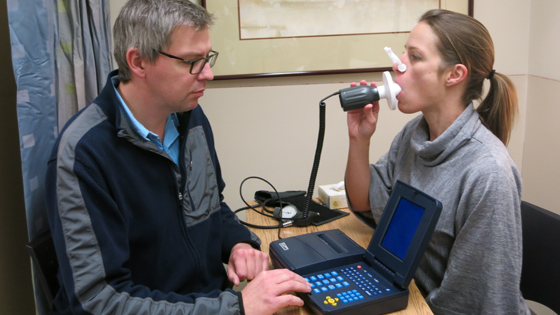
Scott Hines, a respiratory therapist and acting educator and respirologist Dr. Deborah Casey demonstrate spirometry, a simple breathing test used to diagnose COPD, using a bedside (mobile) spirometer.(Photo: UHN)
Chronic Obstructive Pulmonary Disease (COPD) is the fourth leading cause of death in Canada. Yet, it remains under-recognized by the public and many clinicians.
Ontario health data shows that in 2012, 11.4 per cent of Ontarians over the age of 35 (869,645 people) had been diagnosed with the disease. However, many patients with a confirmed diagnosis don't fully understand what it is they have or how to manage it.
On Wednesday November 19th, patients, health-care providers and advocacy groups are coming together to promote World COPD Day to help raise awareness and, according to The Global Initiative for Chronic Obstructive Lung Disease, emphasize the "meaningful actions people with COPD can take to improve their respiratory health."
The Ontario Lung Association and other World COPD Day organizers also emphasize the importance of appropriate diagnostic testing.
"One of the biggest challenges for people with COPD is getting properly diagnosed," says Dr. Deborah Casey, a respirologist at the UHN Asthma and Airway Centre. "Many people with COPD are never diagnosed, while others are only diagnosed when the disease is more advanced and opportunities for early intervention have been missed.
"Other patients have been given the diagnosis of COPD but have never had proper confirmatory testing. This means that some people being treated for COPD actually don't have the disease, a misdiagnosis that is associated with significant costs to both patients and the healthcare system."
It's not too late
COPD is a chronic, progressive lung disease. People who smoke are at most risk for developing COPD, but it also can also affect those exposed to second-hand smoke and environmental pollutants, and there are genetic conditions that predispose people to developing the disease.
Patients who suffer from COPD struggle to breathe as their airways narrow over time, resulting in a reduction in airflow and lung function. Everyday tasks, like walking up stairs or doing housework become increasingly difficult. Unfortunately, many people ignore the initial signs of this disease, believing them to be a part of the natural aging process.
Although COPD cannot be cured, there is a wide range of treatments that can help to reduce the severity of symptoms, and prevent the acute exacerbations, or "lung attacks", that can be severe enough to result in hospital admission. The theme for this year's World COPD Day – It's not too late –speaks to the various treatments and strategies that can help patients achieve the best possible quality of life. These include quitting smoking, a range of drug therapies, oxygen therapy and pulmonary rehabilitation. Unfortunately, many patients with COPD don't receive optimal therapy.
Take a deep breath
The breathing test known as spirometry is the only way to correctly diagnose COPD. This is a simple, non-invasive test where the patient takes a deep breathe, then blows out forcefully into a machine that measures lung function. It is done in pulmonary function labs like those at the Toronto General Hospital (TGH) and Toronto Western Hospital (TWH), but can also be done in outpatient clinics and inpatient wards with the use of inexpensive portable spirometry machines. Despite this, healthcare data suggests that less than half of patients diagnosed with COPD in Ontario have actually had the test.
On World COPD Day, a number of sites around Toronto and Ontario will be offering information on COPD and spirometry testing, including Women's College Hospital in downtown Toronto. Similar initiatives are planned for the TWH in early 2015. For more information on spirometry, you can also watch the following video from the Ontario Lung Association (OLA)
